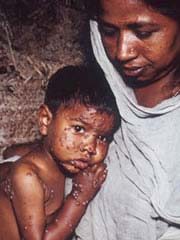Health and Medicine
This subject area encompasses research and studies in the field of human medicine.
Among the wide-ranging list of topics covered here are anesthesiology, anatomy, surgery, human genetics, hygiene and environmental medicine, internal medicine, neurology, pharmacology, physiology, urology and dental medicine.

New technique for detecting cardiac fibrosis
A medical team of the Basque Country has discovered a new technique to detect cardiac fibrosis. After a research carried out during several years, it has been discovered that serum leves of PIP peptide is an indicator of increased myocardial fibrosis.
Fibrosis is formed when scar tissue is accumulated in heart. As a consequence it causes stiffening of the heart and often heart failure. In order to fight against such disease, researchers started looking for an indicator substance in blood.

Scientists find a way to detect which breast abnormalities may develop into cancer
Scientists at the Royal Liverpool University Hospitals in the UK have found a way of testing whether certain abnormalities in a woman’s breast are likely to go on to develop into breast cancer, the 3rd European Breast Cancer Conference in Barcelona heard today (Wednesday 20 March).
Armed with information from the test, doctors could then consider whether the at-risk women should be offered prophylactic anti-oestrogen treatment such as tamoxifen or more frequent screening.
However, D

The role of hormone replacement therapy in breast cancers detected between screenings
Research from the Cancer Registry of Norway has revealed that a higher proportion of women who discover they have breast cancer between mammographic screenings have also used HRT (hormone replacement therapy) at some point in their lives, the 3rd European Breast Cancer Conference heard today (Wednesday 20 March). In addition, these women tend to have denser breasts, and this may be why their tumours were not detected during screening.
Mrs Hege Wang, a researcher at the Cancer Registry of Nor

First European trial for new breast cancer vaccine
European clinical trials are under way in Denmark and the UK testing a new breast cancer vaccine targeted against the HER-2 growth factor.
HER-2 is overexpressed in about a quarter of all breast cancers and has become a key target for new treatments, such as the monoclonal antibody therapy Herceptin.
But, the development of a vaccine by Danish pharmaceutical company Pharmexa represents an entirely novel treatment paradigm, according to Pharmexa’s manager of preclinical development a

Smallpox pill promising
New drug could soon thwart smallpox outbreaks
An anti-smallpox pill could be on the way if a new compound that shows promise in animal tests proves safe and effective in humans. Such a pill could provide the best method for controlling an unforeseen smallpox outbreak, its developers claim.
The need for new ways to treat smallpox has only become an issue in recent years as the threat of a deliberate release of the virus intensifies. Smallpox – a highly contagious and often let

Safe decay detector developed by dentists and textile experts
Tooth decay could soon be detected without resorting to potentially harmful X-rays – by using a novel electrical technique developed by dental researchers at the University of Dundee in an unusual partnership with textile experts at Heriot Watt University.
Laboratory tests show the device, which measures the electrical resistance of teeth, is twice as accurate as current examination techniques and detects decay in its earliest stages when preventive treatment is still possible.
Know